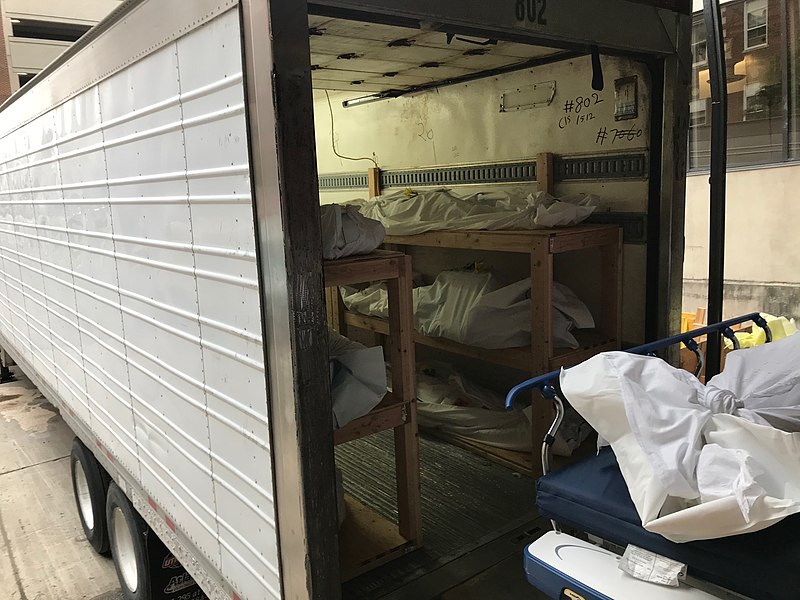10.1 Chapter Overview
Note: With thanks to the people who make our lives and our deaths easier – the front line health care workers, spiritual care workers, and our families. We see you! – Kim Puttman

Figure 10.1 COVID-19 Deceased in Morgue Truck 2020: So many people died unexpectedly from COVID-19 that even dealing with the bodies was a challenge to our health systems. How has COVID-19 challenged our expectations around a good death? Opening Question: What makes a good death?
This chapter may be the most difficult chapter in the whole book. We will be exploring the social problem of death and dying. Some of us have lived with a lot of death in our life. The experience is familiar, even though every death is painful. Some of us have never even thought about death really. Whatever our experience, this chapter can bring up strong feelings and emotions. Please remember to practice good self-care as you walk with us through this material.
And, as much as we once knew about the process of dying and death itself, dealing with death during the COVID-19 pandemic brings its own set of challenges. Please find a box of tissue, and watch the video in figure 10.2.
Figure 10.2 Dying of Coronavirus: A Family’s Painful Goodbye [YouTube Video]
As you watch this 6:50 minute video, please consider:
- Who was involved in this death?
- How was it different from what you might consider a good death?
- How do technology and COVID-19 change how we deal with death and dying?
To put this story in a wider context, more than 6 million people worldwide have died from COVID-19, as of July 2022 (World Health Organization 2022). Although many people would have died anyway, many of these deaths were unexpected. As we discussed in Chapter 7, the level of illness worldwide overwhelmed our healthcare system. The amount of unexpected death overwhelmed our end-of-life systems as well. Hospitals in New York and elsewhere needed to park morgue trucks in their parking lots to handle the number of bodies (figure 10.1). Spiritual care staff including chaplains, pastors, ministers, rabbis, and other religious leaders performed funerals on Zoom, and prayed over burials in uncountable numbers. Every country has been impacted by unexpected death due to COVID-19. You can see the cumulative death counts on the map in Figure 10.3.

Figure 10.3 Global cumulative deaths from COVID-19 reported as of July 2022 https://covid.cdc.gov/covid-data-tracker/#global-counts-rates. Figure 10.3 Image Description
As we consider what may be the most personal of all human experiences, death, we also see that death is a social problem. With the map in figure 10.3, we notice that where you live, by country, changes the likelihood that you will die of COVID-19. Even by this simple measure, death is also a social problem.
As we look deeper, the questions that guide our exploration are:
- How do we explain death and dying as a social problem?
- What are the cultural, social, and structural factors that impact the end of life?
- How does the legislation about right-to-die illuminate our social construction of death itself?
- How does the concept of life course illuminate issues around aging and dying?
- How are individuals and communities creating new possibilities of interdependent improvements to the process of death and dying?
Let’s stare death in the face together!
10.1.1 Licenses and Attributions for Chapter Overview
Chapter Overview by Kim Puttman, licensed under CC BY 4.0.
Figure 10.1 COVID 19 Deceased in Morgue Truck 2020 Chttps://commons.wikimedia.org/wiki/File:COVID19_deceased_in_Hackensack_NJ_April_27.jpg Lawrence Purce, CC0, via Wikimedia Commons This file is made available under the Creative Commons CC0 1.0 Universal Public Domain Dedication Lawrence Purce, photographer COVID19 deceased in Hackensack NJ April 27, 27, April 2020
Figure 10.2 Death under COVID https://www.youtube.com/watch?v=lJ9EbZjcVGY
Figure 10.3 Cumulative death rates by country https://covid.cdc.gov/covid-data-tracker/#global-counts-rates
